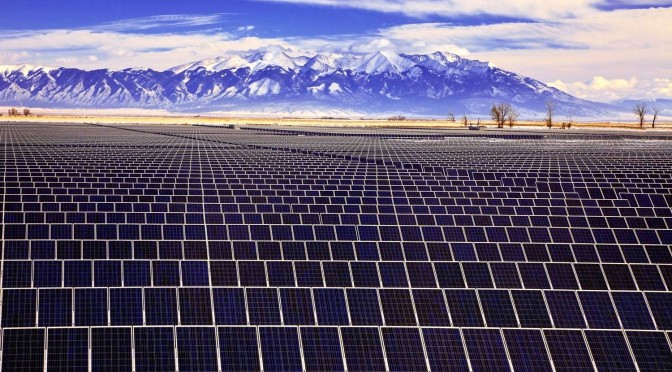Results of a study published in Proceedings of the National Academy of Sciences (PNAS) presents a life cycle assessment (LCA) on an array of electricity generation sources, from fossil fuels to solar power.
The conclusions indicate that renewable energy is cheaper, less environmentally damaging, and has more potential for growth in the next few decades than any conventional electricity generation source.
Renewable energy can even power our entire grid by 2050, if we use our resources wisely.
The study is being hailed as the first ever global-scale LCA of a mix of renewable energy sources. Until now, studies have focused on one energy source at a time in LCAs, if they have been done at all.
A life cycle assessment is a method of study used to estimate the environmental impact caused by all stages of the life of a product, or in this case, energy source, from production to end-use. Finally, we have a better idea of how exactly renewable energy integration will affect our environment, electric grid, and energy bills. Surprisingly, we’ve never studied several renewable resources at once to find an answer. This data gives us solid evidence that renewable energy is fully capable of powering our grid and reducing pollution. The authors conclude, “Our analysis indicates that the large-scale implementation of wind, PV [photovoltaic], and CSP [concentrated solar power] has the potential to reduce pollution-related environmental impacts of electricity production, such as GHG [greenhouse gas] emissions…”
Green energy does come with some environmental impacts, which is why this LCA is so valuable. For the first time, we have information that presents the combined environmental costs of materials, land, manufacturing, and related emissions in one analysis. The raw materials required to manufacture renewable energy generation is not insignificant, but the authors find that materials, emissions, and pollution of renewable energy pale in comparison to the alternative,
The pollution caused by higher material requirements of [renewable] technologies is small compared with the direct emissions of fossil fuel-fired power plants.
In terms of materials required, the study estimates that, “only two years of current global copper and one year of iron production will suffice to build a low-carbon energy system capable of supplying the world’s electricity needs in 2050.”
Demand Response for Renewable Energy
Renewable resources are intermittent in their ability to generate energy; that is always the main argument heard from opponents of wind and solar. The sun does not always shine and wind does not always blow. So, what will happen when a shortage of available power occurs?
Maybe the same thing that happens today: utilities and system operators can trigger a demand response event.
If renewable energy can supply 100% of the world’s power by 2050, as the PNAS study claims, then demand response (DR) will be the best carbon-free asset we will have to keep power stable.
Demand response events are typically triggered during extreme heat waves because energy use spikes (mostly for air conditioning) and stresses the electric grid. But, what if we had DR events on cloudy days instead? Weather radars can predict the extreme overcast conditions that cause solar panels to generate less power. Wind power output could be similarly predicted since air pressure and changes in cold and warm front weather patterns are already monitored. Currently, demand response events can be forecast days when extreme weather conditions are predicted. I don’t see why the same can’t be done for solar and wind power. Triggers for DR events would simply change in accordance with sustainable electricity generation patterns. This process wouldn’t be much more disruptive to the power grid than it is today, especially when you consider the fact that cloudy days are usually pretty windy.
Demand response will get a technology upgrade too; by 2050 we’ll have better storage technology than we do now. Batteries can store any excess power generated by renewable energy systems. Such technology is already being developed; it won’t be long before it’s up and running. This means even more grid stability. Batteries can replace generators for DR participants. Instead of firing up a diesel generator as backup power, facilities could switch over to batteries that store excess energy from on-site solar panels or windmills.
Climate Change is Killer
According to the International Energy Agency (IEA), without efforts to stop pollution, CO2 emissions from the energy sector will roughly double by 2050. Considering that the earth is already showing effects of climate change, that statistic is chilling. In a 2010 report, the IEA published a graph estimating the CO2 emissions poured into the atmosphere by 2050 if we do nothing (baseline scenario), versus the lesser amount if we act to stop carbon pollution (BLUE Map):
Graph depicting the CO2 emissions of the IEA’s estimated BLUE Map and Baseline Scenarios
Image credit: IEA Energy Technology Perspectives 2010
The baseline scenario will emit almost 60 gigatons of carbon dioxide into the atmosphere by 2050. There’s no doubt that will wreak havoc on Earth’s climate, and all aspects of human livelihood.
Reducing greenhouse gas emissions is vitally important, as we all already know. The Intergovernmental Panel on Climate Change (IPCC) tells us in its Climate Change 2014: Synthesis Report that,
It is virtually certain that there will be more frequent hot and fewer cold temperature extremes over most land areas on daily and seasonal timescales, as global mean surface temperature increases. It is very likely that heat waves will occur with a higher frequency and longer duration. Occasional cold winter extremes will continue to occur.
Virtually certain environmental disasters should be enough to motivate us all to make some changes in how we think about energy. It’s time to shake up the electric grid and stop pouring carbon into the atmosphere before we reach the point of no return.



